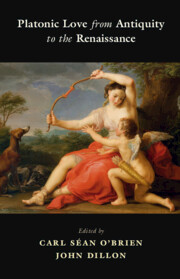Book contents
- Platonic Love from Antiquity to the Renaissance
- Platonic Love from Antiquity to the Renaissance
- Copyright page
- Contents
- Acknowledgements
- Notes on Contributors
- Introduction
- Part I Love in Plato
- Part II Development of Platonic Love in Antiquity
- Part III Love and Metaphysics during the Middle Ages
- Part IV Platonic Love during the Renaissance
- Chapter 12 Human and Divine Love in Marsilio Ficino
- Chapter 13 Marsilio Ficino and Leone Ebreo on Beauty
- Chapter 14 Pico della Mirandola on Platonic Love
- Chapter 15 The Contra-Amorem Tradition in the Renaissance
- Chapter 16 Castiglione and Platonic Love
- Chapter 17 Platonic Love in Renaissance Discussions of Friendship
- Bibliography
- Subject Index
- Index Locorum
Chapter 15 - The Contra-Amorem Tradition in the Renaissance
from Part IV - Platonic Love during the Renaissance
Published online by Cambridge University Press: 25 August 2022
- Platonic Love from Antiquity to the Renaissance
- Platonic Love from Antiquity to the Renaissance
- Copyright page
- Contents
- Acknowledgements
- Notes on Contributors
- Introduction
- Part I Love in Plato
- Part II Development of Platonic Love in Antiquity
- Part III Love and Metaphysics during the Middle Ages
- Part IV Platonic Love during the Renaissance
- Chapter 12 Human and Divine Love in Marsilio Ficino
- Chapter 13 Marsilio Ficino and Leone Ebreo on Beauty
- Chapter 14 Pico della Mirandola on Platonic Love
- Chapter 15 The Contra-Amorem Tradition in the Renaissance
- Chapter 16 Castiglione and Platonic Love
- Chapter 17 Platonic Love in Renaissance Discussions of Friendship
- Bibliography
- Subject Index
- Index Locorum
Summary
Texts that warn of the dangers of passionate or excessive love have a history in Western culture going back to antiquity. Writings in this contra-amorem tradition typically characterize obsessive love or lovesickness as a disease and then offer remedies for the sufferer. When interest in Marsilio Ficino’s doctrine of Platonic love began to spread from Florentine philosophical circles to aristocratic courts throughout Italy in the late fifteenth century, some authors writing in the contra-amorem tradition responded directly to the new enthusiasm for Ficino’s ideas. A comparison of two contra-amorem texts – Bartolomeo Platina’s ‘pre-Ficinian’ On Love (c. 1466) and Battista Fregoso’s ‘post-Ficinian’ Anteros (1496) – will illustrate the ways in which the later text directed its arguments against Ficino’s doctrine, and did so with an audience of aristocratic young men particularly in mind. It is noteworthy that Anteros predates the first vernacular popularizations of Platonic love in Pietro Bembo’s Asolans (1505) and Baldassare Castiglione’s Book of the Courtier (1528), and also that Castiglione’s Courtier responds, in turn, to Anteros by assimilating some elements from that work into its own treatment of Platonic love.
Keywords
- Type
- Chapter
- Information
- Platonic Love from Antiquity to the Renaissance , pp. 238 - 257Publisher: Cambridge University PressPrint publication year: 2022
- 1
- Cited by

